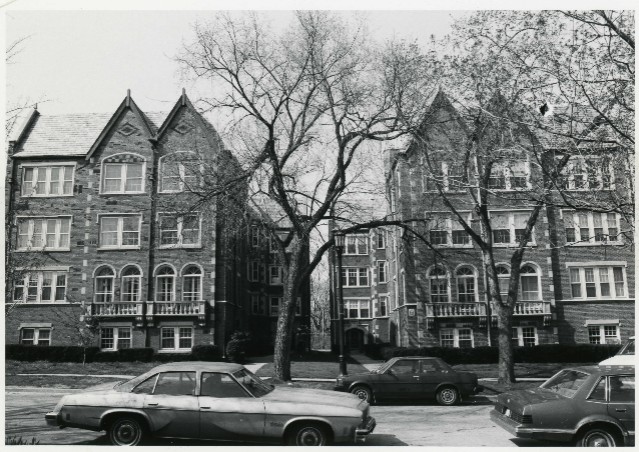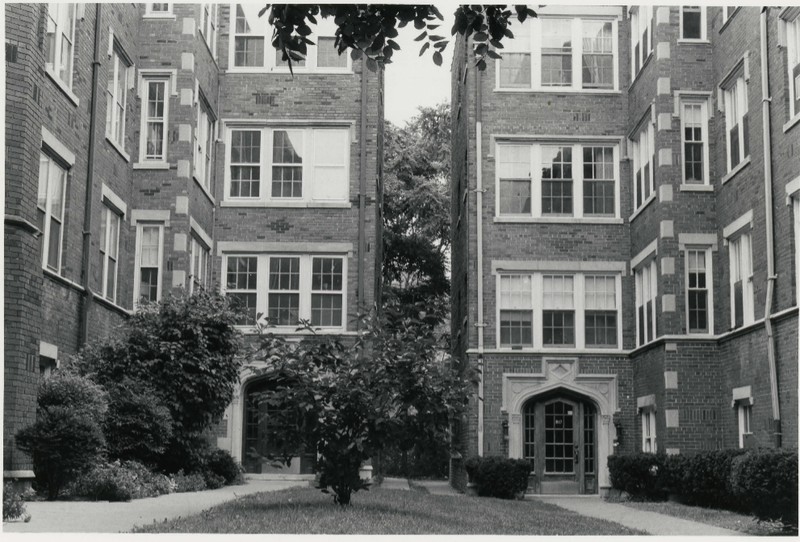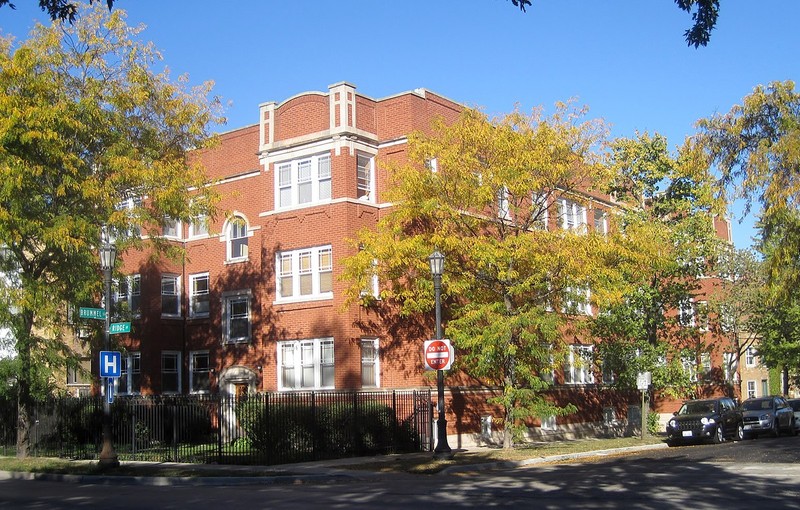Buildings at 815-817 Brummel and 819-821 Brummel
Introduction
Text-to-speech Audio
Built two years apart (1927 & 1928), by two different architectural firms, the two L-shaped apartment buildings face each other, forming what appears to be a single, U-shaped apartment complex, minus a tiny walkway that separates the two. Unique to the Brummel buildings, the two half-courtyards also face each other, allowing for what appears to be a large courtyard space. In part, the courtyard space provided by both owe their existence to the changing cultural values during the early part of the 20th century; progressive Americans sought to promote healthier living than what was common in urban environments. Urban crowding also played big part in why many fled the cities for suburban communities.
Images
September 1983 - Wide view of two apartment complexes with shared courtyard.

September 1983 - Close-up view of two apartment complexes with shared courtyard.

Taken 2012, courtyard not in view.

Backstory and Context
Text-to-speech Audio
Two apartments built by two different architectural firms, two years apart (1927 and 1928) share fantastic symmetry and, in the end, appear to exist as one apartment complex. Both built with an L-shape but opposite in direction, the two structures both include a half courtyard that faces each other -- thus appearing as one, sizable courtyard square.
The necessity for courtyards in apartments built in the 1920s stems from a societal shift associated with Progressive Era ideals, and the apartments built in the suburbs arose from Chicago's rapid population rise and concurrent urban crowding.
As Chicago grew from swampland in the mid-nineteenth century to one of the world's biggest cities in the 1920s, it became exceptionally congested. Hence, many people sought refuge by moving to the suburbs, such as Evanston, IL, an option that evolved due to a rapid transit system that connected Evanston to Chicago's downtown, created during the first two decades of the twentieth century.
The strong U.S. economy not only helped Chicago enjoy its "Bungalow Boom" in the 1920s when the city produced 100,000 single-dwelling cottages but also led the tremendous growth in apartment construction nationwide; an average of 226,000 multiple-family dwelling units arose each year from 1924-1928. However, in Chicago and Evanston, as was the case in many places, apartments enjoyed features that would promote healthier living than typically found in urban slums or other forms of crowded urban living spaces.
Progressive Jane Addams exerted influence nationally, but even more-so in her hometown of Chicago (and the suburbs) by promoting that healthy living led to healthy citizens, which meant for a better democracy. An example of her influence can be seen with apartments such as the two structures constructed in 1927 and 1928 at 815-817 Brummel and 819-821 Brummel. Both buildings adhered to the principal of dedicating at least 20% of lot space for outdoor use, and it occurred in such a way as to create one larger, common outdoor area. Both buildings enjoy a half courtyard that faces each other, forming one, ample outdoor space. Though Addams didn't have direct ties to this construction, she brought awareness to the harms of living in dark, urban spaces. Many sought to create, or find, living spaces that differed from those type of conditions.
Sources
Babcock, Richard F., and Fred P. Bosselman. "Suburban Zoning and the Apartment Boom." University of Pennsylvania Law Review 111, no. 8 (1963): 1040-091. doi:10.2307/3310792.
Brown, Victoria Bissell. "Jane Addams," in Women Building Chicago 1790-1990: A Biographical Dictionary. edited by Rima Lunin Schultz and Adele Hast. Bloomington: Indiana University Press, 2001.
Duis, Perry R. Challenging Chicago: Coping with Everyday Life, 1837-1920. Urbana, IL: University of Illinois Press, 1998.
Hansmann, Della. "Chicago Building Types: The Courtyard Apartment." Moss Architectural Design. September 30, 2014. http://moss-design.com/courtyard-apartment/.
Hoffmann, John, editor. A Guide to the History of Illinois. New York: Greenwood Press, 1991.
"Nomination Form: Suburban Apartment Buildings in Evanston Thematic Resource: 815-817 Brummel and 819-821 Brummel." National Register of Historic Places. January 30, 1984. Digitized form currently found at the National Archive Catalog at https://catalog.archives.gov/id/28890896
Prosser, Daniel J. "Chicago and the Bungalow Boom of the 1920s." Chicago History 10.2 (1981): 86–95.
Quinn, Patrick. "Evanston." Encyclopedia of Chicago. . Accessed April 11, 2018. http://www.encyclopedia.chicagohistory.org/pages/438.html
Wilson, Mark R.. "Construction." Encyclopedia of Chicago. . Accessed April 11, 2018. http://www.encyclopedia.chicagohistory.org/pages/331.html.
Brown, Victoria Bissell. "Jane Addams," in Women Building Chicago 1790-1990: A Biographical Dictionary. edited by Rima Lunin Schultz and Adele Hast. Bloomington: Indiana University Press, 2001.
Duis, Perry R. Challenging Chicago: Coping with Everyday Life, 1837-1920. Urbana, IL: University of Illinois Press, 1998.
Hansmann, Della. "Chicago Building Types: The Courtyard Apartment." Moss Architectural Design. September 30, 2014. http://moss-design.com/courtyard-apartment/.
Hoffmann, John, editor. A Guide to the History of Illinois. New York: Greenwood Press, 1991.
"Nomination Form: Suburban Apartment Buildings in Evanston Thematic Resource: 815-817 Brummel and 819-821 Brummel." National Register of Historic Places. January 30, 1984. Digitized form currently found at the National Archive Catalog at https://catalog.archives.gov/id/28890896
Prosser, Daniel J. "Chicago and the Bungalow Boom of the 1920s." Chicago History 10.2 (1981): 86–95.
Quinn, Patrick. "Evanston." Encyclopedia of Chicago. . Accessed April 11, 2018. http://www.encyclopedia.chicagohistory.org/pages/438.html
Wilson, Mark R.. "Construction." Encyclopedia of Chicago. . Accessed April 11, 2018. http://www.encyclopedia.chicagohistory.org/pages/331.html.
Photo Sources
September 1983 (both photos): Cynthia Fuller. Both are screenshots of PDF file provided by the National Parks Service, found at https://catalog.archives.gov/id/28890896.
Taken 2012: By Teemu008 from Palatine, Illinois - Buildings at 815-817 Brummel and 819-821 BrummelUploaded by AlbertHerring, CC BY-SA 2.0, https://commons.wikimedia.org/w/index.php?curid=29481299
